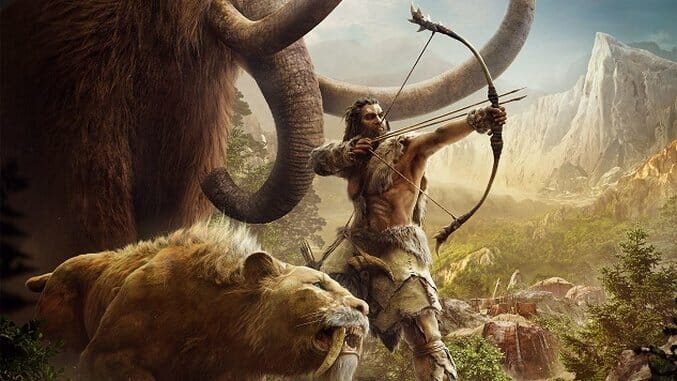But, recycling project though it may be, it’s far from alone. For example, Saints Row 4, a game that made creative reuse of assets from Saints Row 3, was pretty damn good. And Far Cry Primal, for all it takes from Far Cry 3 and 4, does bring something of its own to the table. Set in central Europe during the mid-Stone Age, it portrays the power struggle between three developing cultures, the Wenja, the Izila, and the Udam. Takkar, a Wenja warrior and the protagonist of the game, can tame and ride animals, and uses an owl to scout locations and drop bombs on his enemies. Hunting, a major feature of the series, not only has greater emphasis but also makes more sense in the game’s context of prehistoric tribal warfare, the primitive nature of its societies rendering the politics far less complicated. If anything, Far Cry Primal seems more honest, all pretense for violence stripped away to its simplest explanation.
As a portrayal of the prehistoric era, Far Cry Primal is far from a proper history lesson. In writing the game, however, Ubisoft Montreal were not content to rely on fiction, researching Proto Indo European language and the development of early human beings to influence and shape the its content. Crafting and hunting also better support the game’s themes of evolutionary progression than in previous Far Cry titles, as do the changes to the outpost system. Instead of rescuing rebels and strengthening the numbers of your resistance movement by establishing survivors in defensive settlements, in Far Cry Primal the player defends or liberates enslaved tribal members and sends them back to Wenja villages, opening up new survival techniques as their numbers grow. In that sense, while Far Cry Primal relies on the mechanics and identity first established by its predecessors, at times it makes better use of them. Somehow, making weapons and capacity upgrades seems less selfish when it’s in the interest of advancing a fledgling society, as opposed to the one-man-army ambitions that drove protagonists of Far Cry games past.
In Far Cry Primal, the sarcastic edge of the series is gone. There are no morally ambiguous choices to make or “the asshole was you all along” cut scenes to endure. The Udam want to eat you, the Izila want to sacrifice you. The ethical dilemmas that otherwise personify the series have no place in the Mesolithic era. And with that, the player is free to enjoy the game for what it is: an ancient safari hunt in the virtual sunshine. Far Cry Primal is the videogame equivalent of reheated leftovers: sure you’ve had it before, but boy does it hit the spot.
Holly Green is a reporter, editor, and semiprofessional photographer living in Seattle, WA. She is also the author of Fry Scores: An Unofficial Guide To Video Game Grub.
You can find her work at Gamasutra
, Polygon
, Unwinnable
, and other videogame news publications.